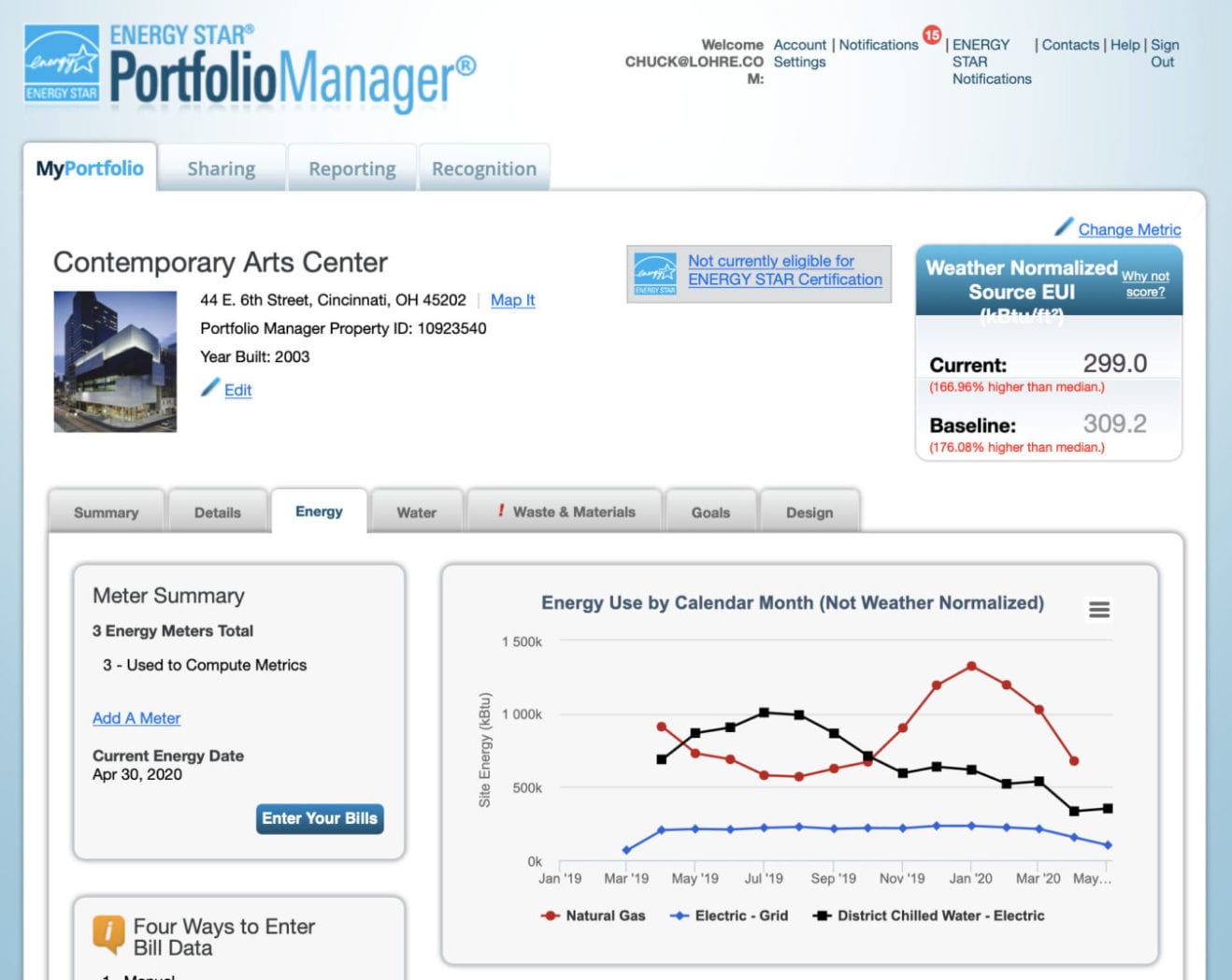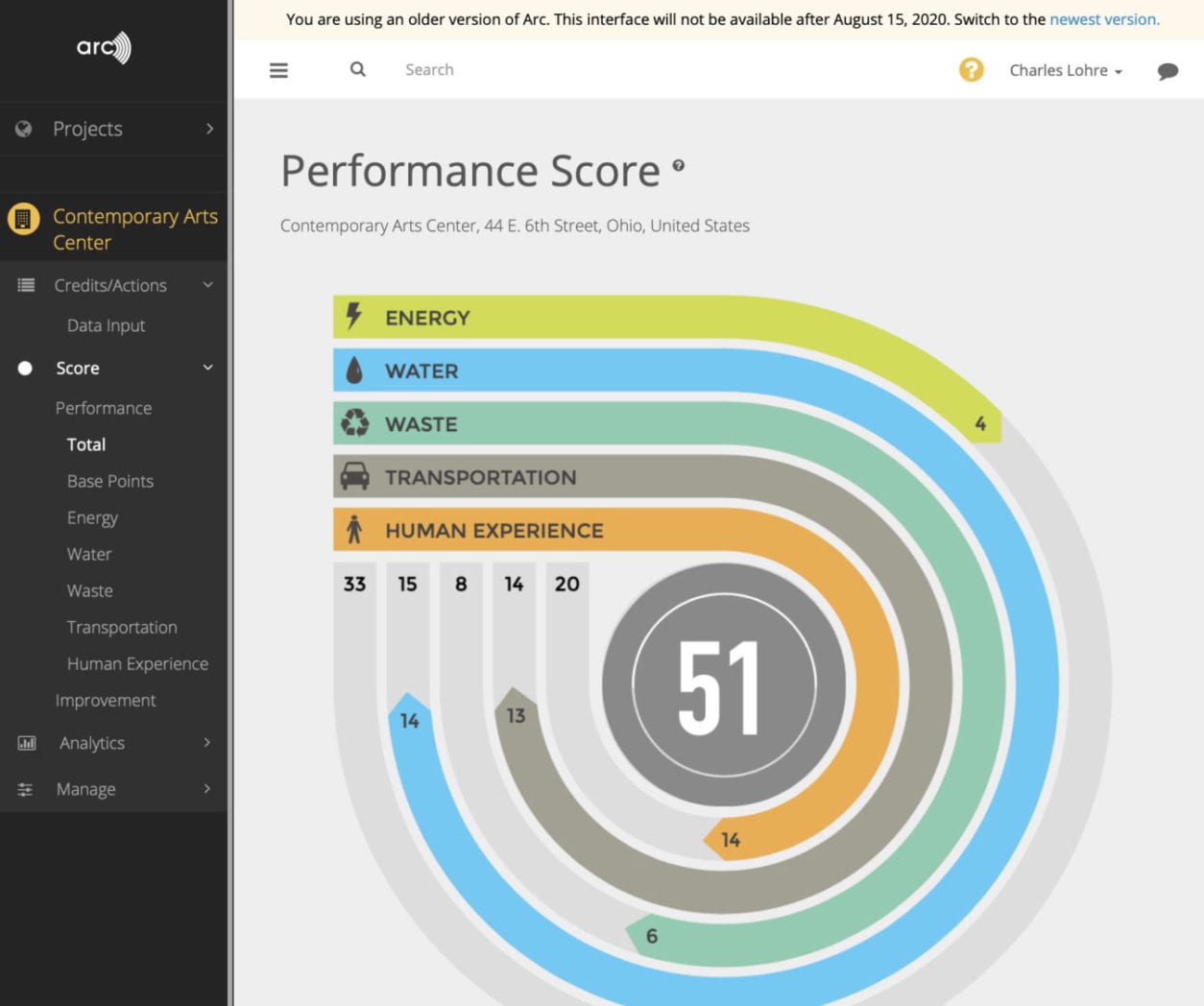The Easy Way to Start Meeting Your 2030 District’s 50% Energy Reduction Goals
Photo by Roland Halbec
(Thanks to the 2030 District of Cincinnati, managed by Green Umbrella, for encouraging the CAC to write this article and promoting it in their August 4th newsletter. The link in the newsletter goes to the CAC’s 2030 District Profile page, https://www.2030districts.org/company/contemporary-arts-center. PDF link.)
The CAC is one of the founding members of the 2030 District, whose ambitious goal is to reduce energy use by 50% from a 2003 baseline of all buildings in the District collectively. The CAC’s leadership comes from the many environmental exhibitions held at the facility. The second and third LEED homes in Cincinnati were inspired by a competition show at the CAC. Their presenting artists have led the way in showing how art has a natural environmental awareness.
Joining the 2030 District gave the CAC a way to demonstrate their commitment to the environment. Although, the goals are lofty the requirements to get started are easy. Just enter your data into a computer program developed by the Environmental Protection Agency (EPA) called ENERGY STAR® Portfolio Manager®. The Energy Star plaque is something you see on many buildings, it recognizes the building has met the required energy efficiency goals for the appropriate award. The 2030 District has chosen the ENERGY STAR Portfolio Manager as the reporting criteria for their members. Besides energy, water and transportation emissions are to be reduced by 50% by 2030 and improvements in occupant health and wellness are to be included.
This screen shot is the Energy tab on the CAC’s ENERGY STAR Portfolio Manager site. It illustrates that our District Chilled Water and Natural Gas usage are both at high levels throughout the year. Our goal is to lower District Chilled Water use in the winter and lower Natural Gas use in the summer by changing the building’s control programming without adversely affecting the requirements of the artwork and occupants.
Cutting the environmental effects of the building in half is the goal but the first thing that is needed is to report your usages. Other 2030 Districts are reporting over 70%, Cincinnati is just above 30%. The purpose of this article is to encourage members to take the first step and enter their data. There are no requirements to make the data public, but the CAC is willing to do so to start an environmental awareness conversation.
The CAC staff and volunteers assembled a year’s worth of bills and entered them into the program. The energy the Zaha Hadid designed building uses is wind turbine electricity from Texas, chilled cold water from a central plant in downtown Cincinnati, and natural gas from Constellation Energy distributed by Duke Energy. Zaha Hadid’s design shoehorns an “L” into the corner of Walnut and Sixth Streets in downtown Cincinnati. It has south and east facing windows of double pane construction and four inches of high quality insulation on the roof. A continuously poured concrete face is the main north face and structural masonry units make up the west and north west leg. The building’s HVAC controls tempers the distributed air throughout the building. From the inputs the site calculates the building’s Energy Utilization Index, a unit for the energy use per square foot per year. The CAC’s EUI is 232. To meet the average requirements for the 2030 District it would need to be 24 by 2030.
EUIs vary by building and usage type, the Commercial Building Energy Consumption Survey (CBECS) and Portfolio Manager, shows how widely EUIs vary by building type, size, location, occupancy, internal operations, etc. The category in which museums fall in the CBECS is “Public Assembly”, but one can easily argue there are often big differences between museums.
Site EUIs as of 2016 for restaurants and bars average 224. EUI average is 384 for fast-food restaurants where there’s higher/faster traffic in/out. Grocery stores average 186. In-patient healthcare averaged 233. Malls average 108. From small to large, there’s usually a “sweet spot” where EUI is somehow automatically lower than all sizes above or below. Among all commercial building types in 2016, those with 10,001 to 25,000 sf had the lowest EUI average of 62. Average for a 100,000 sf building was 76. The CAC is 86,500 sf.
The CAC’s water WUI is .8, which is very low for a building of this type because it doesn’t have to take into account the District Chilled Water’s cooling tower water use.
The criteria for 2030 District reporting transportation emissions and improvements in occupant health and wellness have not yet been determined. The CAC is currently using the U.S. Green Building Council’s carbon footprint reporting system called ARC. It surveys the occupants for the ways they get to work and their comfort in the building. Air quality monitors are used to report volatile organic compounds, particulate matter and carbon dioxide levels. With the pandemic keeping everyone home, the CAC’s transportation index is 91, versus a 74 local average and 81 global average. Their Human Experience index is 70, versus 67 local and 53 global averages. The USGBC’s reporting gives the CAC 51 points. A minimum of 40 points is required to be LEED Certified as well as having to meet minimum energy requirements and prerequisites such as no smoking in the building.
This screen shot is the USGBC ARC Performance Score for the CAC building. A minimum score of 40 is required to be LEED Certified and you need to meet minimum energy use requirements. The CAC’s Energy score needs to be about 20 to meet the minimum.
The CAC will have to get their EUI about 30% less if they are to even qualify for LEED Certification. Leadership in Energy and Environmental Design (LEED) requires buildings to meet minimum energy use requirements. The CAC has made the first step in meeting their 2030 District membership requirements by adding their data to the ENERGY STAR Portfolio Manager. The next step they are taking is to evaluate the building’s energy use and management. With proper controls the building’s energy use may be reduced by at least 10%. The CAC plans to apply for the Cincinnati 2030 District Member Funding Opportunity grant. With it they are going to double check the operation of the HVAC system and implement changes to the controls to achieve at least a 10% improvement.
The CAC looks forward to sharing more of their journey with the 2030 District Regions. It’s by sharing their experiences that we all will be able to start on the path to achieve our mutual goals that at this time may seem unrealistic; but that is the challenge and we’re committed to achieving it through innovation and common sense. You can’t change what you don’t measure.
Chuck Lohre, CAC Trustee and volunteer helping the CAC’s building achieve LEED Certification on the journey to meet the 2030 District goals collectively with all of the members.



